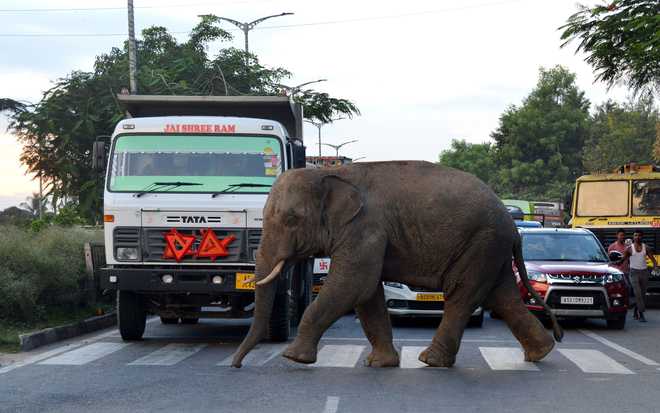
Commuters stop their vehicles as a wild male elephant walks across a road on the national highway at Boragaon, in Guwahati on August 9, 2018. PTI photo
Vibha Sharma
Tribune News Service
New Delhi, August 12
On the World Elephant Day—the celebration of mystical and mythological ‘gaja’, India's national heritage—animal conservationists and rights activists have expressed concerns about loss of their habitats and corridors, leading to a rise in number of human-elephant conflicts.
Actually, there are two main concerns: one, though the number of elephants are increasing, their natural habitats are shrinking and getting fragmented. And two, development activities inside protected areas—building of rail lines, dams, infrastructure projects et al—are adding to the pressures, driving them out of the habitat to engage in more conflicts with humans.
Prerna Singh Bindra a conservationist and former member of the National Board for Wildlife says India must afford protection to elephant habitats and corridors if it wants to save the "benign social" animal.
“On an average about 80 elephants are killed each year in India. Between 2009-10 and 2016-17 approximately 655 elephant deaths were reported due to human-wildlife conflict and of these more than 120 deaths were due to train accidents,” she says.
Jose Louies, head of the crime control division at the Wildlife Trust of India (WTI), adds the government, the Centre that is, must build a conservation policy and infrastructure that is elephant-friendly. “It is doable. Rather a long-sighted development vision would only help India gain given the scope of wildlife tourism. But elephant killings have increased due to man-animal conflict and poaching. It is important to protect their natural habitat if you want to see elephants in future,” he warns.
According to Louies, the WTI has identified 101 elephant corridors across 11 states in India, of which only half are currently secure.
"While elephant populations are largely concentrated in protected forests in the north-eastern states, east-central India, the Himalayan foothills in the north, and the Western and Eastern Ghats in the south, the animals require free movement between these areas to maintain genetic flow and offset seasonal variations in the availability of forage and water,” WTI says.
India is home to more than half of the world’s Asian elephant population, protected under the Schedule-I of the Wild Life (Protection) Act, 1972. “In India elephants make up 60 % of the world’s Asian elephant population. Where once India’s forests were teeming with elephants, now only approximately 86,000 sq. km of disconnected pockets mark their geographical range in the country and the health of the remaining forests and migratory corridors is failing. Apart from their natural migratory behaviour, elephants are now forced to wander further in search of food due to a lack of wild habitats and scarcity of resources,” Bindra says.
“Devastation of forests, coal mining as well as industrial development and new rail and road networks fragmented the region. This, inevitably, sees herds of elephants crossing railway lines that run through sensitive wildlife areas, including protected areas and designated wildlife corridors,” she adds.
Elephant corridors are important because as forest lands continue to be lost, these relatively narrow, linear patches of vegetation form vital natural habitat linkages between larger forest patches. "They allow elephants to move between secure habitats freely, without being disturbed by humans. In many cases, elephant corridors are also critical for other wildlife including India’s endangered tigers," Louies explains.
Spread over 14 states, India’s 29 elephant reserves include areas of human use and habitation. In fact unless they lie within existing reserve forests or the Protected Area network, elephant reserves are not legally protected habitats in themselves, hesays, adding that a large chunk of elephant habitat is unprotected, susceptible to encroachment or already in use by humans.



























